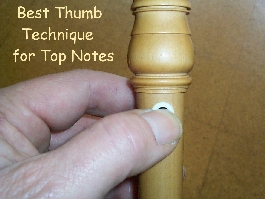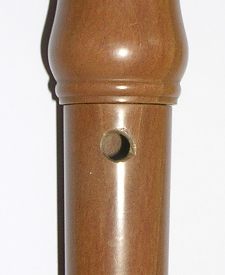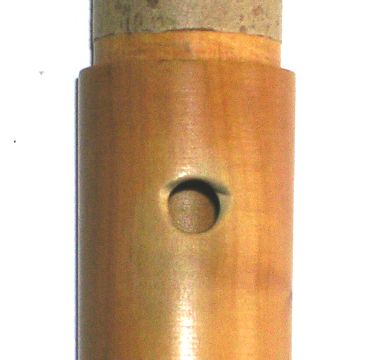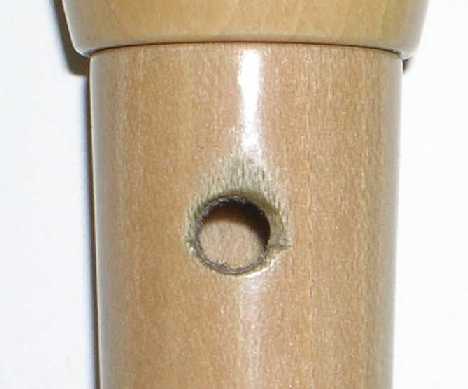Saunders Recorders
Bristol UK
TOP NOTES
It helps if you understand why some notes do not come easily. The troublesome ones are not natural to the instrument. The lowest notes are, in technical terms, "fundamental" (a good word), the lowest sound that the resonance of the air in the tube can produce. When you move higher up the recorder's tube there comes a point where you must start over again (D# on the descant). These further notes are harmonics. To help the sound to come, the thumb hole must be at least partly opened. As one goes higher the opening becomes critical. Fully open which is passable for E is no good at all for A. For B you start over yet again, still with the thumb hole partly open, but with the third hole open as well. These additional openings are not functioning as "note holes", they are promoting the formation of a harmonic as opposed to fundamental mode of air vibration.
Cast your aural and visual memory around. Have you seen a guitarist, violinist or harpist lightly touching the string they are sounding and heard a high sound of different tone colour? When they do this they are playing harmonics. How do bugles and historic trumpets and horn produce so many different notes without the use of any valves? It is done by playing harmonics.
There is a common question "How on earth do you do that?". And there is a stock answer "With difficulty.".
Given a certain amount of dedication and aptitude the task becomes easier as skill is acquired. I believe everyone can become a passable, perhaps even "good" performer on the recorder. It takes a special sort of person to be a virtuoso.
To get difficult skills right is not easy because many factors are involved and success only comes when you "Get it all together.". Watch, as I have done recently with a grand child, a baby learning to crawl. Bottom up, a must, and then reach and wriggle but forward movement only happens when the legs move in the right sequence with the hands. It takes time, but then there is no stopping, apart from learning how to stand, and toddle, and walk, and jump, and run like the wind.
The lowest recorder notes are not too much of a problem, cover the holes completely and don't blow too hard or the tone will come out too high (a harmonic). But... how much thought do you give to the way the note starts and finishes? Does it scoop and fade? Does the pitch soar and swoop? Do you get a pre-echo as your breath precedes your tongue? Do you get a thud as your tongue bounces back? Have you actually got it all together to make a beautiful sound? Are these difficult questions? I have some more!
Have you learned any scales? Do you actually listen to the sound you are making? Can you hear the sound of the note you are about to play "in your head"? Do you know what is coming or is it "pot luck". Is your practice just "doing it over again", right or wrong?
The ability to produce a beautiful sound and high notes in particular is largely in the mind. Know your enemy, show no fear... overcome!
So much for the inner game. Now for practicalities. Some recorders are easier than others. Unfortunately easy top notes are not a primary design feature for expensive recorders, interesting sound is more important than ease. Predictability is, though, very important. Some cheap instruments can have easy top notes, at the expense of poor intonation or bland sound. One thing worth trying though is to pull the head out a fraction. If you are lucky the top F will improve without creating intonation difficuties in the lower registers.

The most common difficulty is the size of the thumb hole opening. It is generally not small enough. I am a firm believer in the thumb nail approach to partly closing the hole. Or should I change the emphasis by saying "partly opening" it. The term used by some American writers, "cracked", is more graphic and descriptive than the common English usage "pinched". The opening should also be towards the top of the recorder. An opening "down the side" (see below) will not do at all. Also, the rest of the thumb hole must be fully covered. If you have trouble do check this. It is all too easy to open up a crack along the lower boundary of the hole, especially on a large holed renaissance model, or even a 'Dream' descant. (Flutes, of any kind, do not have 'octave keys' but other woodwinds do. The oboe has at least two and the holes are so small that a pin will not fit into them.)

Here is a picture (below) of a hand made boxwood treble recorder showing thumb hole wear after about thirty years of intensive use by a good player. It still plays very well and there is no need to do anything about the thumbnail mark which shows absolutely no sign of being cut by the nail.

Here by way of contrast is a link to a picture of a good recorder damaged by attempts to play the highest notes. The player was unaware of the correct technique. Plastic recorders are more forgiving. They are harder wearing and are often 'easier' up high. The downside is that they do not produce the soloist quality sound of a good wooden instrument.
I have recently realised that the concept of 'well worn' can be contrasted with 'badly worn'. If you analyse the pattern of wear above you notice that the steep edge to the goove is towards the top of the recorder. Contrast this with the next picture, where the steep edge is towards the bottom of the recorder. This (descant) has been 'gouged'. The thumb action has always been downwards, too far and too forcefully. This hole is 'badly worn', and the softwood has been unable to withstand the cutting action of the nail. This recorder will benefit from a thumb hole bushing repair. However, the top notes will only come sweetly if the player uses better technique.

Your thumb nail should be trimmed (with clippers or scissors and emery board) blunt and level with the flesh of the end of your thumb. If you are in the habit of using your teeth, leave your left thumb out of it. You can work to re-habilitate your other digits as time goes on, as a performer, your hands will be noticed. Buy yourself a manicure set! Yes, boys too! (I have been this way, a very long time ago. The manicure set advice was given to me by a senior scout when I was still in short trousers. It was some of the best advice I have ever had. The principle can be applied to most of life's problems.)
By resting your trimmed nail across the hole (never ever dig in) and gently sliding it up and down you can judge very nicely how near to full closure the hole is. The "feel" is important. It becomes part of your memory for a note, your acquired skill. Listen as you play, the note will be too sharp, as well as difficult to sound if the opening is too great. I believe that the hard edge a well trimmed nail gives to the opening is important. Musical instruments work better with cleanly defined features. If you are in the process of regrowing your nail, do not attempt to do it all in one go. There must be no void behind the nail end. You will find that it is best not to raise your knuckle above the hole. If you do, the opening you make is very much larger that you expect and very difficult to close. (See the picture above.)
Be sure to play separate tongued notes once you have got the feel of the right opening. The amount of attack and breath pressure need to be judged and remembered. Experiment so as to discover, and remember the amount of variation any particular note will stand.
Practise your tonguing rhymically, playing up and down passages of scales or arpeggios. It is important that your coordination between fingers, tongue and breath is spot on so that the music is crisp and tidy.
Above all, listen to the sound you are producing and try altering aspects of your playing so that you optimise the effect and "Get it all together.". You need to establish a loop of quality control feedback from your ears through your brain down to your breathing, tongue and fingers. A good teacher, whose style you can copy, is your best route to good playing. If you cannot find one seek out some recordings. There are many players who have not made it big time but have recorded interesting music. If your interest is in classical music, go carefully when considering a recording of folk music played on a recorder. It may not be a good model for you to emulate. Making music is one of the most complicated and rewarding of human activities. It takes time and application to achieve significant results. Keep at it, and reap the rewards of perseverance. (Remember, nobody sold a computer game to a child by telling them it was easy!)
Top F# Supplement
Perhaps some of you were as disappointed as I to find so little practical advice in a recent published article. Here are my thoughts and suggestions on this subject.
Most treble (alto) wooden baroque recorders can be made to play top F# by adding a key to cover the end of the recorder, or closing it with a pad or your knee. Closing the end of the recorder (hole 8) when fingering either top F natural or top G gives top F#. (01--|45--8 or 01-3|4-6-8, the little finger is applied to the key, not hole 7. There is nothing to be gained by closing hole 7 if you use your knee to close hole 8.) Click here to see how the key is made. I believe it was first applied to Dolmetsch instruments.
There are several reasons why these are not a good ways to go. A new key is invasive, anachronistic and costly. Stopping the end of the recorder in public performance is a distraction, and you may damage your lips or teeth. Some recorders actually can play top F#, (some Coolsma and Dolmetsch for example). Try my suggestions and see how you get on. If all else fails, cheat!
In my experience, a recorder that does not demand the last finger down (hole 7) for top G will produce a passable top F#. Closing hole 7 will flatten the G, and closing hole 5 or hole 2 will lower it even more. Experiment, you may find that partly closing the extra holes, either, or both, will give you a good F# that you can articulate.
You may find that the 'trill' or slur fingering, 01--|4---- will actually sound when tongued. Try it! This may be your answer, particularly on recent Mollenhauer trebles.
If you cannot find a perfect solution, bear in mind that this note is generally regarded as "impossible", and cheat.
Cheat? Yes, cheat! What you generally need is a note between F and G. A very sharp F will do, and you may be able to bamboozle the listener completely if it is followed with a very sharp G, (little finger off) and the music is quick. If you need a note that is long enough for its intonation to be subject to scrutiny the best course may be to avoid it all together and transpose the passage. Be more inventive than just dropping the octave. This is not an admission of defeat, it is artistic licence. Remember, top F# is supposed to be impossible, there should be no shame in adapting the music to your instrument.
* See below for my thoughts on the Telemann Concerto in C.
Top F# has been "impossible" for a long time and does not feature significantly in the baroque repertoire. The composers knew what they were doing. Other instruments have similar problems, with the baroque flute it is top F natural. When you poach repertoire intended for another instrument it is not entirely surprising that there are some difficulties. The obvious transposition that matches the fingering between different wind istruments may not be a good idea. Mozart's oboe concerto is in C, but the "matching" flute concerto is in D.
Most recorders will produce a usable top F# with the fingering 01--|4---, but only in a slur from E. It is very difficult to hold on to, but it is good enough for a trill once you have the knack of moving two fingers together. It can be used with care in runs. Even if the run is detached you can cheat, and get away with it, by slipping in a slurred pair.
"Modern" recorders cannot justify themselves unless they solve the impossible note problem, and they generally try to add extra compass into the bargain. The baroque recorder and the baroque flute are unusual in that their bore has two distinct sections, parallel near the mouth and contracting for the rest. The tone holes are also very small in relation to the bore. While evening out the bore and enlarging the holes are ways to extend the range and facilitate harmonics, they have a large and, to my old fashioned ears, unwelcome effect on the tone quality. A missing note outside the normal compass should not be regarded as a "fault". It is the result of the laws of physics and human physiology. The harmonics refered to above do not fall conveniently under the finger holes of wind instruments with non-linear bores. In some ways it is as though the instrument is working like a guitar with strings that are thicker at the nut than they are at the bridge. I have been told by string players that old strings "play out of tune". At first I found this a difficult concept but then realised that a string would get "fatigued" over the part that had the most use and would become non-uniform. While nonlinearity is a fault in a stringed instrument it has advantages in woodwind. The small holes and contracting bore have a calming effect on resonance widely regarded as leading to a beautiful sound quality.
The instrument which has the most radically different construction from the recorder is the saxophone. Beauty of sound is not its most noticeable characteristic. I regard "modern" recorders with a certain amount of suspicion. As a very longstanding player of the modern flute I have wondered about the reason for my antipathy to the "modern" recorder and have come to put it down to two primary factors. The recorder lacks the infinitely variable voicing characteristic of the flute player's lips and it does not have the subtle bore contraction at the top end. A "modern" recorder with a "parabolic" (Boehm's inaccurate but evocative description) headjoint, and a wide, parallel, large holed body might be an interesting instrument with a beautiful sound and no impossible notes. But, it would probably need octave keys, and would be very difficult to keep in tune. I did once play a modern flute fitted with a recorder style windway (invented by Wheatstone of concertina fame). The sound, though clear, had no character or virility. I am thankful that nobody has resurrected it for "educational" use. There are good practical and musical reasons why the Boehm flute now rules the contemporary roost. The baroque recorder, with or without top F# is and always has been a wonderful vehicle for musical expression. Do not lose sight of this in the fog of the modern demand for "perfection".
* The Telemann Concerto in C (EM 1065B) is a problem piece. The Top F#s occur in melodic passages that do not lend themselves to glossing over. A little adaptation is called for. Having compared the current edition of the famous Quantz Flute Concerto in G with the one I learned the piece from in the 1950's and found that passages, very attractive but impossibly high for a baroque flute, have been re-set down an octave (back to the original pitch?) in the current edition, I view the 1960 Moeck edition of the Telemann with suspicion. 'Herausgegben' can cover a multitude of sins. I suggest that you adapt the recorder part along the following lines.
- First Movement. Bars 36 and 101, play D instead of F#.
- Second Movement. Bar 116, play D#. Bars 145 and 149, play the E for a quaver's length.
- Fourth Movement. Bar 49, play one octave lower, as far as, and including, the D at the start of bar 50.
This page first hit the web at the start of the C21! Over the years I have tweaked it and the baby mentioned above has become a teenager... The Top F# article was in Recorder Magazine, if I remember correctly. From time to time I get appreciative emails from players who found that I had enabled them to break out of a discouraging loop and achieve sweet and reliable upper octave notes. My latest addition (27th. December 2016) relates to large thumb holes and an extra, unintended crack. It is the result of some experimentation following comments received relating to a Dream descant that I sold a few months ago.
John Everingham